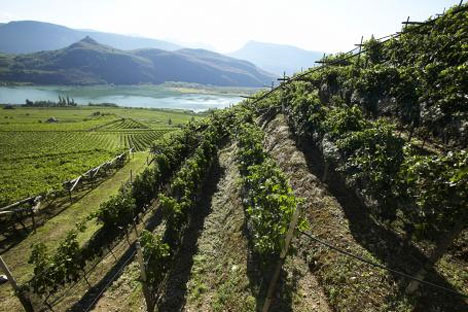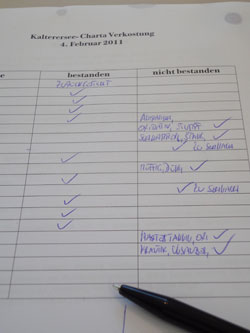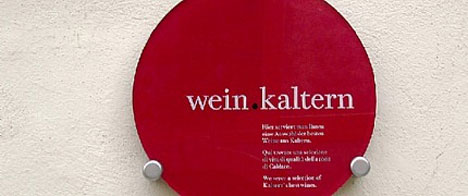Kalterersee: It has been produced at a high level for years. However, many people do not know this or do not want to or cannot believe it. For them, Kalterer is still a snack, hiker's and tourist wine and not a wine to be taken seriously. The opposite is the case: Kalterersee has been a wine to be taken seriously for some time now - but a pleasantly uncomplicated one. Starting with the 2010 vintage, this is to be demonstrated clearly and self-confidently to the outside world with the "Charta Kalterersee" label.
The "Charta Kalterersee
In February 2010, 19 local producers created a statute with which they would like to give their very own wine the status it deserves in their opinion by setting high quality standards and they committed themselves to bottling their "best Kalterersee wines under the quality seal of the Kalterersee Charter". The Charta-Kalterer should "present itself with a bright light to strong ruby-red colour, fruity-fresh aromas with notes of cherries and raspberries, bitter almond and violet tones, and a harmonious mild taste.The wine is presented with a harmonious, mild, dry and velvety structure, with soft tannins and pleasant acidity, stimulating, wholesome and inviting - a wine for light, uncomplicated enjoyment - at any time of the day and on any social occasion". On the one hand, this is a broad definition, but on the other hand, it also makes it quite clear what the Charta-Kalterersee is supposed to be and what it is not: not a concentrated blockbuster wine, but a wine that is a pleasure to drink at any time. Any time, because it is pleasantly uncomplicated; with pleasure, because it has quality.

|
| The top Arzenhof vineyard on Lake Kaltern (Source: Baron di Pauli) |
The sites play a major role for the Charta wines. Because the grapes for them may only come from "the best sites around Lake Kaltern, where the soil, orientation and microclimate have always been considered particularly suitable for the Vernatsch grape" (from which the Kalterersee wine is made) ". The vines from which the grapes for the Kalterersee Charter wines are pressed must have an average age of at least 30 years" and the yields may be a maximum of 125 quintals per hectare", i.e. at least 20% below the DOC regulations currently in force. In the cellar, the Charta wines are "traditionally fermented on the skins and gently matured", without "enrichment and any methods that distort the natural character of the wines". The Charta wines are bottled only in 0.75-litre bottles or multiples thereof" (All quotes from Charta Kalterersee).
The selection of the Charter wines
"The suitability of the Kalterersee Charter wines is checked by a jury of experts in a blind tasting. The jury consists of seven members: One representative of each of the two cellar cooperatives of Kaltern, one representative of the private wine producers of Kaltern, a South Tyrolean cellar master, two specialist journalists or sommeliers as well as a wine expert from another wine-growing region". In this way, the aim is to combine the competence of the local experts with the critical distance from outside. The first tasting took place on 4 February 2011 and the samples hired were subjected to a tough test. Eight of the 17 wines were put on hold for the time being. Since all of them were barrel samples, all the deferred wines were tasted a second time two months later. The spectrum of accepted wines is broad. And that is the pleasing thing: No wine style is rated. The Charta-Kalterersee can be a light, finely fruity, almost rosé-coloured wine; but also a dense, rather dark and quite concentrated drop. The only decisive question for its inclusion as a Charter wine was: Is it good in its own way as a Kalterersee? If it comes across as a light wine that is too thin and harmless, this is of course just as little the case as if it presents itself as a concentrated growth that is austere and off-putting. The spectrum of Charta wines therefore ranges from the delicately fruity, light Kalterersee like that of the Bärentalerhof of the Morandell family to concentrated, yet always supple wines, such as the Vernatsch colossus 'Kalkofen' by Baron di Pauli, made from vines that are on average 50 years old, or the 'Olte' by Baron di Pauli, made from even older vines (70 - 90 years!).) from even older vines (70 - 90 years!) by Thomas Pichler.
How do you recognise the Charta wines?
The wines recognised as Charter wines by the expert jury receive the quality seal of the Kalterersee Charter. This is "a protected capsule, which is marked with the Kalterersee logo and guarantees the distinctiveness of the wines."

|
| The Charter seal (source: wein.kaltern) |
The wines of the first Charta vintage 2010
When the Charta wines were announced, I was a little surprised

|
| It was selected quite strictly (Source: Brunner) |
In July, both the Charta-Kalterer and all other Kalterersee wines from the Charta member wineries will be tasted by Wein-Plus. Perhaps there will be one or two wines in the top range that did not pass the Charta test due to their need for ripeness. The results will probably be announced here in the Wein-Plus magazine in July.
The initiators: wein.kaltern
wein.kaltern was founded in 1999 by winemakers, tourists, farmers and representatives of public life as the "Project Group Wine Village Kaltern". They wanted to show "that the wine village of Kaltern not only wants to cultivate the wine-growing tradition and preserve the importance of wine culture for social life, but also that a quality offensive is underway here". The naming was intended to emphasise the connection between wine and origin. The initiatives since the founding of wein.kaltern are manifold: events such as Kaltern all in white, which present the wine village in a new light; the wine trail, on which one can learn information about the various vineyards (Riegel) with their special characteristics and thus experience the wine village in a very real way while hiking; the matching wine hiking day, a gourmet theatre, various tastings, the wine house on the market square and now the Kalterersee Charter.
The local gastronomic establishments have also been taken to task for quality wine and, if they want to use the wein.kaltern logo, they must offer a certain number of quality wines from Kaltern on the open bar in addition to good food. A good opportunity to get to know the high-quality growths of the village in a fitting ambience.

|
| The red dot - a distinctive feature of the member wineries (Source: wein.kaltern) |
In the future, the "South Tyrolean Wine Academy" is to be established in Kaltern, where a complete range of courses will be offered to those interested in wine - "from wine taster courses for beginners to more in-depth basic courses for wine lovers".The courses will range from wine taster courses for beginners to in-depth basic seminars and 'wine academics'; from entertaining, informal evening events to intensive block events lasting several days for budding professionals."In addition to the main house in Kaltern, other wine villages in South Tyrol are to be included, i.e. seminars and events will be offered at various locations. - This decentralised concept is intended to actually live up to the claim of being a South Tyrolean wine academy.
Book Tip: Wine Reading in Kaltern
In 2006, wein.kaltern invited 19 writers to put into words their very personal impressions of this long-established and now newly awakening wine village. This they have done. The result is a series of extremely animating texts, most of which are cheerful, light-hearted and seem to come off the cuff (the good wine from Kaltern has certainly often played a decisive role in the writing process), but there is also serious and historical background knowledge about the wine from Kaltern. A wonderful booklet to browse through on site or as a souvenir at home. Perfect for reading before, after or with a glass of wine from Kaltern.
Wine Reading - Wine and Landscape, Soil and People, History and Stories in Kaltern
Publisher wein.kaltern ISBN-10: 3-7082-3211-9